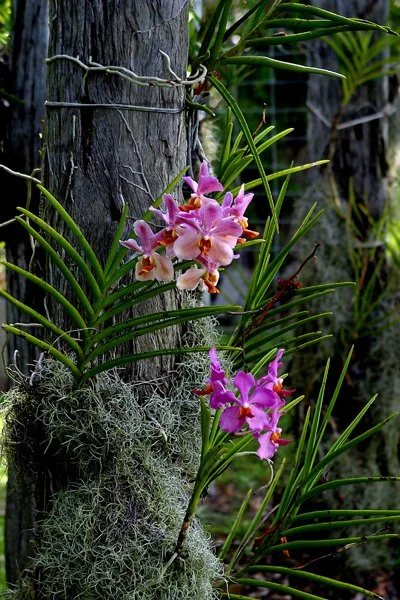The Orchid I Want But Have Been Too Scared To Get
Vanda orchids (photo credit: ekenitr via Flickr, CC BY-NC 2.0)
Even the most fervent orchid enthusiasts have gaps in their collections. How could it be
otherwise given that there are 28,000 species?! Most of us start off with phalaenopsis or
moth orchids—those are the types you see in grocery stores, florist shops, and on the
desks of administrative assistants. They’re the most popular and one of the easiest
types of orchids to keep alive, but they’re also just the tip of the iceberg.
In an early orchid blog post about branching out beyond phalaenopsis, I recommended
cattleyas. Later, I suggested dendrobiums, jewel orchids, oncidiums, paphiopedilum,
and more. But there’s one major genus I haven’t written about, which is strange given
that they have among the most striking blooms: vandas.
Vandas growing (photo credit: unknown via PxHere, Creative Commons CC0)
Vandaceous orchids include roughly 40 species from across Asia, Australasia, and the
Philippines. They grow on tree tops, clinging with their long roots and enjoying the
humidity. They’re generally categorized as “expert” orchids, rather than “beginner”
orchids because they have higher light and water demands than many other orchids,
and they’re not supposed to be potted up.
Vandas require a lot of light, but as with most other orchids, direct sunlight will burn
them. They need to be grown in a place where they get 8-12 hours of bright indirect
light—greenhouses are perfect, but many people don’t have the ideal spot to keep
them. Most growers hang them high up, where they’re more likely to get good light and
good air circulation.
Vanda orchid growing at Kew Gardens, UK (photo credit: Joelle Renstrom)
If you’ve ever seen an orchid growing without any pot or growing medium, chances are
it was a vanda. Their roots become incredibly long and dangle down, which means they
also dry out quickly. Growers water them multiple times a week either by dunking or
soaking the roots and/or by spraying them thoroughly with room temperature water (it’s
important not to use cold water, as it shocks them). Watering in the morning is best, as
the water can evaporate throughout the day and not contribute to rot. Vandas can also
be grown in wooden, slatted baskets, so long as their roots are exposed and not in bark.
They like being fertilized once a month.
Vanda orchids on old bridge timbers (photo credit: MaX Fulcher via Flickr, CC BY-NC 2.0)
Vandas like warmer weather—around 80 degrees Fahrenheit is their sweet spot. Like
other orchids, colder nights (down to 55 degrees Fahrenheit) are okay and can help
induce blooming. Vanda flowers are particularly brightly colored, largely to attract
pollinators. One of them, the coerulea is blue—a rare color for orchids. That one is the
exception to the rule in that it enjoys cooler temperatures than the others.
Part of the reason I don’t have a vanda is because I’m not sure I have the best place to
put it for the conditions it requires. But I’m more motivated than ever to figure it out!




